Hydrangea macrophylla Flower
No flower shifts its identity as dramatically—or as enchantingly—as the Hydrangea macrophylla. With its lush, showy blooms and captivating ability to change color depending on the soil it grows in, this flowering shrub has become a beloved favorite in gardens around the world. Whether you're looking to soften a shaded border, create a romantic floral hedge, or simply enjoy a living watercolor display, Hydrangea macrophylla never disappoints.Known commonly as Bigleaf Hydrangea, this species has captivated gardeners for centuries with its dramatic mophead and lacecap flowers, glossy foliage, and unique sensitivity to soil chemistry. It's no wonder it continues to be one of the most cherished ornamental shrubs in temperate gardens.
Both types bloom in mid to late summer, often lasting well into autumn. The flowers gradually dry out on the plant, offering a beautiful faded charm as the seasons shift.What truly sets Hydrangea macrophylla apart is its color versatility. Unlike most flowering plants, hydrangea color is not solely genetic—it’s influenced by the soil’s pH level and aluminum availability.
This phenomenon occurs because acidic soils allow plants to absorb aluminum more readily, which contributes to the blue pigmentation. Gardeners often manipulate bloom color using soil amendments like sulfur (to lower pH) or lime (to raise pH).Hydrangeas love consistent moisture, especially during bloom time.
Mulch helps retain moisture and regulate soil temperature.



